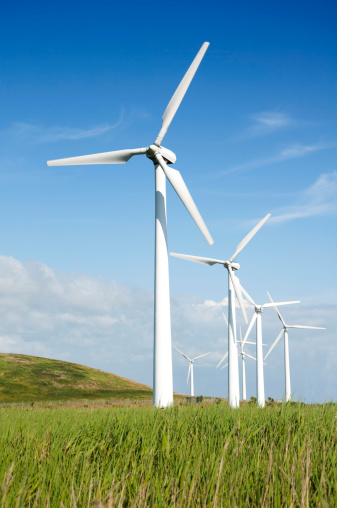 Advanced wind turbines are accessing faster, steadier winds at higher altitudes so they can generate more electricity, creating a modern-day wind boom as new areas in the Great Lakes states and the southeastern U.S. become economical sites to develop more wind energy.
Advanced wind turbines are accessing faster, steadier winds at higher altitudes so they can generate more electricity, creating a modern-day wind boom as new areas in the Great Lakes states and the southeastern U.S. become economical sites to develop more wind energy.
According to AWEA, modern wind turbines require a wind speed of 5 m/s per to begin generating electricity at utility-scale quantities. The technology advancements are so great that AWEA says wind sites with comparatively lower average wind speeds can now be considered for commercial turbines for the first time.
‘The Great Lakes region is an early beneficiary of this,’ says Emily Williams, AWEA's deputy director of industry data and analysis. ‘In states like Michigan, we're absolutely seeing a wind rush.’
With continued technology advancements, states that currently have no commercial wind turbines at all, primarily in the Southeast, will see development opportunities open up in the coming years.
High-wind areas are becoming even more productive, thanks to longer blades, as the average annual ‘capacity factor’ or percentage of the maximum rated capacity that a turbine generates year-round now exceeds 50% in some cases. Others are receiving a variety of refinements to existing turbines, such as blade tip extensions, vortex generators and improved electronics, making them more productive.
These innovations have contributed to a drop in the price of wind-generated electricity. The levelized cost of wind energy (LCOE) has dropped 58% in just five years, according to the most recent study by Wall Street financial advisory firm Lazard. LCOE is the net cost to install and operate a turbine, divided by its expected lifetime energy output.
In 2014, the average rotor diameter of wind turbines installed in 2014 was 99.7 meters, with an average hub height of 82.4 meters, and more than 80% of the wind turbines installed during the past year had a rotor diameter greater than 100 meters. That size increase results in a 17.4% increase in the area of wind captured by a wind turbine since 2011, when the average rotor diameter size for turbines installed was 92.0 meters. The power of the wind is directly proportional to the swept area of the blades, so increased rotor diameters allow for development in lower wind resource areas. Taller towers make it economical to build in areas where wind speeds at 80 meters might be too low or too turbulent, as increased heights reach higher, steadier wind speeds.
Advances in wind turbine technology also include increases in nameplate capacities over time. The average turbine rating of a wind turbine installed during 2014 was 1.94 MW, eight times larger than that of a typical turbine in 1990, generating 17 times more electricity.



